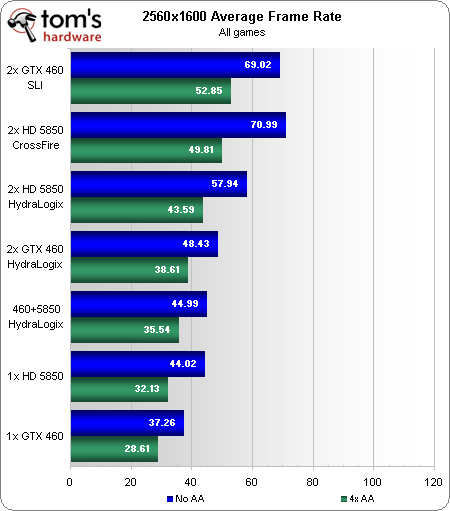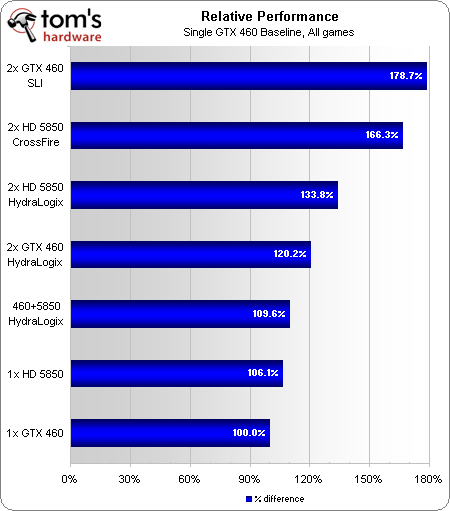HydraLogix Vs. SLI And CrossFire: MSI's P55A Fuzion Tested
LucidLogix forges ahead with its promise of multi-GPU compatibility across multiple graphics architectures and platforms. Today we see how its latest drivers stand up to the performance standards of CrossFire and SLI on a much more cost-sensitive board.
Performance Evaluation
No matter which benchmarks we chose, someone was going to hate us. Lucid documents 145 titles on its compatibility list, yet not all of those titles benefit appropriately from its technology. We’ve even seen instructions on how to select games to best highlight the capabilities of Lucid’s technology, but that's not how we roll. We pick our benchmarks based a combination of popularity, repeatability, and intensiveness. This is the only method we know to provide truly unbiased results, and it's the only way hardware can earn our respect.
While HydraLogix provided very good results in some games, others saw no benefit at all. This is easily seen in our 1680x1050 averages, but Lucid claims that its benefits are more pronounced as graphics load increases.
The 1920x1200 results show similar scaling but at slightly lower FPS for all configurations.
Even at 2560x1600, lacking support in some games diminishes Lucid’s solid results in others. The overall difference between SLI and N-mode (Nvidia) drops from around 53% to around 40%, while A-mode (AMD) drops from a 26% disadvantage to 19% behind CrossFire.
Choosing the weakest card as our baseline, we can see on a percent scale how far each improvement takes us. This chart might not have been completely required for experienced readers, but its numbers will be re-used in our efficiency calculations.
Get Tom's Hardware's best news and in-depth reviews, straight to your inbox.
Current page: Performance Evaluation
Prev Page Benchmark Results: S.T.A.L.K.E.R.: Call Of Pripyat Next Page Power And Efficiency-
duk3 Looks good on the 1st 2 games and synthetics.Reply
I hope Lucid gets all the issues worked out. -
anacandor So basically it's just a universal CF/SLI connecter built into the motherboard? Seems odd that it's taken this long to be developed, but great nonetheless :)Reply -
Darkerson Looks like it has some promise, if they can further work the kinks out. Something to keep an eye on in the future.Reply -
punnar I can see it as a standard in the future. I think I will buy a board with Hydralogix on my next build.Reply -
Yargnit It would have been nice to see how well this works with two differing AMD/ATI cards and two Nvidia cards. For instance someone has a GTX260 and wants to add a GTX460, or someone with a AMD5850 who wants to pick up a new 6870 (damn numbering change) to go with it.Reply
Also comparing performance pairing two cards from the same generation (say GTX 460 + GTX 470) vs differing generations. (GTX 260 + GTX460)
Lastly what affect would pairing a two cards with varying amounts of memory have? (two regular versions of a card vs 1 reg + 1 dbl memory vs 2 dbl memory) Since it isn't clear from what I've read if both cards would be limited to lowest memory level or not.
Interesting tech for sure -
sudeshc this should become a standard, allowing us to enjoy features from both manufacturers. I would also be prepared to pay few extra bucks for this as well.Reply
-
Maziar Overall,Lucid is a great idea of mixing different cards but it still needs quite a lot of work with drivers.Reply -
Yargnit Ah, thank you. It was posted before I was frequently following the site, I'll give it a look.Reply




